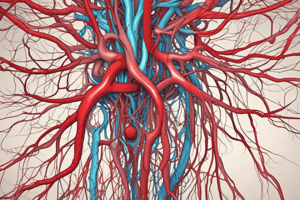Podcast
Questions and Answers
Which blood vessels carry oxygenated blood back to the left atrium?
Which blood vessels carry oxygenated blood back to the left atrium?
- Pulmonary veins (correct)
- Arteries
- Pulmonary arteries
- Veins
What is the primary goal of the pulmonary circulation?
What is the primary goal of the pulmonary circulation?
- To carry nutrients from the digestive tract to the tissues
- To carry oxygen from the lungs to the tissues
- To oxygenate blood and remove carbon dioxide (correct)
- To remove carbon dioxide from the tissues
Which part of the vascular system has lower pressure and vascular resistance compared to the systemic circuit?
Which part of the vascular system has lower pressure and vascular resistance compared to the systemic circuit?
- Systemic circulation
- Veins
- Pulmonary circulation (correct)
- Arteries
What is the purpose of blood flow redistribution during exercise and rest?
What is the purpose of blood flow redistribution during exercise and rest?
Which layer of blood vessels is composed of concentric layers of smooth muscle cells?
Which layer of blood vessels is composed of concentric layers of smooth muscle cells?
Which of the following statements about blood flow during exercise is true?
Which of the following statements about blood flow during exercise is true?
Which type of blood vessels have uniquely thin walls composed of only endothelial cells and basement membrane?
Which type of blood vessels have uniquely thin walls composed of only endothelial cells and basement membrane?
Which of the following statements about large arteries is true?
Which of the following statements about large arteries is true?
Which mediator is responsible for preventing orthostatic hypotension?
Which mediator is responsible for preventing orthostatic hypotension?
Which mediator is responsible for reducing circulating volume by stimulating natriuresis and diuresis?
Which mediator is responsible for reducing circulating volume by stimulating natriuresis and diuresis?
Which mediator is targeted by the heart failure drug sacubitril?
Which mediator is targeted by the heart failure drug sacubitril?
Which mediator is tonically produced by normal endothelial cells and promotes vasodilation?
Which mediator is tonically produced by normal endothelial cells and promotes vasodilation?
Which of the following factors is the main determinant of vascular resistance on a minute-to-minute basis?
Which of the following factors is the main determinant of vascular resistance on a minute-to-minute basis?
Which of the following represents the greatest amount of resistance in the systemic circulation?
Which of the following represents the greatest amount of resistance in the systemic circulation?
Which of the following statements is true regarding the dual role of arterioles?
Which of the following statements is true regarding the dual role of arterioles?
Which of the following is NOT a short-term regulator of blood pressure?
Which of the following is NOT a short-term regulator of blood pressure?
Which hypothesis of autoregulation suggests that decreased pressure and flow result in buildup of vasodilator metabolites that produce vasodilation, while increased pressure and flow wash out vasodilator metabolites, producing vasoconstriction?
Which hypothesis of autoregulation suggests that decreased pressure and flow result in buildup of vasodilator metabolites that produce vasodilation, while increased pressure and flow wash out vasodilator metabolites, producing vasoconstriction?
Which hormone is secreted by the juxtaglomerular apparatus of the nephrons in response to low blood pressure?
Which hormone is secreted by the juxtaglomerular apparatus of the nephrons in response to low blood pressure?
Which enzyme converts angiotensin I to angiotensin II?
Which enzyme converts angiotensin I to angiotensin II?
Which receptor is activated by vasopressin, leading to vasoconstriction?
Which receptor is activated by vasopressin, leading to vasoconstriction?
Which of the following occurs when the arterial wall weakens in response to increased pressure, causing a viscous cycle of dilation, increased radius, increased tension, and ultimately a weakened wall?
Which of the following occurs when the arterial wall weakens in response to increased pressure, causing a viscous cycle of dilation, increased radius, increased tension, and ultimately a weakened wall?
Which of the following is true about blood flow velocity and cross-sectional area?
Which of the following is true about blood flow velocity and cross-sectional area?
What is the most important biochemical mediator for maintaining vessel patency and vascular wall health, and lowering blood pressure?
What is the most important biochemical mediator for maintaining vessel patency and vascular wall health, and lowering blood pressure?
Which of the following is a major pathophysiological change associated with the abundance of sympathetic nervous system activity in arterioles?
Which of the following is a major pathophysiological change associated with the abundance of sympathetic nervous system activity in arterioles?
Which of the following is a baroreflex compensatory response to an acute drop in blood pressure?
Which of the following is a baroreflex compensatory response to an acute drop in blood pressure?
What is the effect of sympathetic stimulation on the sinoatrial node?
What is the effect of sympathetic stimulation on the sinoatrial node?
What is the effect of sympathetic stimulation on the cardiac ventricles?
What is the effect of sympathetic stimulation on the cardiac ventricles?
What is the effect of sympathetic vasoconstrictor activity on vascular smooth muscle?
What is the effect of sympathetic vasoconstrictor activity on vascular smooth muscle?
What is the most likely cause of the patient's spell?
What is the most likely cause of the patient's spell?
What are the two hypotheses of origin for hypertension?
What are the two hypotheses of origin for hypertension?



